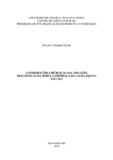| dc.creator | Pereira, Desydere Trindade | |
| dc.date.accessioned | 2021-04-17T00:59:03Z | |
| dc.date.available | 2021-04-17T00:59:03Z | |
| dc.date.issued | 2019-03-01 | |
| dc.identifier.uri | http://repositorio.ufsm.br/handle/1/20619 | |
| dc.description.abstract | The veterinary literature is scarce of studies showing the series of traumatic disorders of the spinal cord and of the cauda equina. In front of this, the aim of this study was: to conduct a survey of cases of fractures and vertebral luxation that affected dogs assisted in the service of Neurology of a Higher Education institution from 2007 to 2018, with the intention of elucidating the main etiology of trauma, as well as the prognosis of functional recovery after surgical or conservative treatment (article 1). A prospective study was also accomplished of spinal cord surgical procedures with dogs showing the main complications on the trans-operative and post-operative , immediate and late (article 2). In the first article, 109 dogs with trauma on the spinal cord and cauda equina were chosen, secondary to extrinsic factors, having as the main cause the road traffic accidents. Among these patients, it has been possible to have telephone contact with 41 tutors, in which 21 out of them have gone through surgical stabilization, and 20 patients which have gone through conservative treatment. In the second article, a prospective study was conducted with the ere has been the inclusion of 34 dogs with the clinical hospital routine with spinal injuries that have performed surgical procedure of decompression or stabilization of the spine. In 76.47 % of the patients, it has been observed at least one complication in some of the stages of the evaluation, being the main ones: intra-operative bleeding, seroma in the immediate post-and urinary infection in the late post-operative. The contribution of the analysis of these two studies is that the traumatic injury of spinal cord causes damages that can be irreversible. Therefore, it is interesting that there are more and more researches in this field of study, in order to assist the veterinary and patients who suffer this kind of injury. | eng |
| dc.language | por | por |
| dc.publisher | Universidade Federal de Santa Maria | por |
| dc.rights | Attribution-NonCommercial-NoDerivatives 4.0 International | * |
| dc.rights.uri | http://creativecommons.org/licenses/by-nc-nd/4.0/ | * |
| dc.subject | Medula espinhal | por |
| dc.subject | Cão | por |
| dc.subject | Neurologia | por |
| dc.subject | Doença do disco intervertebral | por |
| dc.subject | Fraturas | por |
| dc.subject | Luxações | por |
| dc.subject | Spinal cord | eng |
| dc.subject | Dog | eng |
| dc.subject | Neurology | eng |
| dc.subject | Intervertebral disc disease | eng |
| dc.subject | Fracture | eng |
| dc.subject | Luxation | eng |
| dc.title | Contribuições cirúrgicas nas afecções traumáticas da medula espinhal e da cauda equina em cães | por |
| dc.title.alternative | Surgical contributions of traumatic affections of the spinal cord and of the cauda equina in dogs | eng |
| dc.type | Tese | por |
| dc.description.resumo | A literatura veterinária é escassa de estudos que demonstrem a casuística de afecções traumáticas na medula espinhal e da cauda equina. Diante disso, o objetivo deste trabalho foi: realizar um levantamento dos casos de fraturas e luxações vertebrais que acometeram cães atendidos no serviço de neurologia de uma instituição de ensino superior no período de 2007 a 2018, com a intenção de elucidar a principal etiologia do trauma medular e da cauda equina, bem como o prognóstico da recuperação funcional após o tramento cirúrgico ou conservativo (artigo 1). Foi realizado também um estudo prospectivo em cães submetidos à cirurgia da coluna vertebral, demonstrando as principais complicações no trans-operatório e pós-operatório imediato e tardio (artigo 2). No primeiro artigo, foram selecionados 109 cães com trauma na medula espinhal e cauda equina secundários a fatores extrínsecos, sendo a principal causa o atropelamento. Desses pacientes, foi possível contato telefônico com 41 tutores, sendo 21 de pacientes que passaram por estabilização cirúrgica e 20 de pacientes que receberam tratamento conservativo. No segundo artigo, realizou-se um estudo prospectivo com a inclusão de 34 cães da rotina clínica hospitalar com lesões medulares que realizaram procedimento cirúrgico de descompressão ou estabilização da coluna vertebral. Em 76,47% dos pacientes se observou ao menos uma complicação em alguma das fases da avaliação, sendo as principais: hemorragia no trans-operatório, seroma no pós-operatório imediato e infecção urinária no pós-operatório tardio. A contribuição da análise desses dois estudos é que a lesão traumática da medula espinhal ocasiona danos muitas vezes irreversíveis. Sendo assim, é interessante que haja cada vez mais pesquisas nesse âmbito, com o intuito de auxiliar o médico veterinário e os pacientes que por venturam venham a sofrer esse tipo injúria. | por |
| dc.contributor.advisor1 | Mazzanti, Alexandre | |
| dc.contributor.advisor1Lattes | http://lattes.cnpq.br/3504517995843014 | por |
| dc.contributor.referee1 | Beckmann, Diego Vilibaldo | |
| dc.contributor.referee2 | Aiello, Graciane | |
| dc.contributor.referee3 | Valente, Fernanda Soldatelli | |
| dc.contributor.referee4 | Pinto Filho, Saulo Tadeu Lemos | |
| dc.creator.Lattes | http://lattes.cnpq.br/5572990290958341 | por |
| dc.publisher.country | Brasil | por |
| dc.publisher.department | Medicina Veterinária | por |
| dc.publisher.initials | UFSM | por |
| dc.publisher.program | Programa de Pós-Graduação em Medicina Veterinária | por |
| dc.subject.cnpq | CNPQ::CIENCIAS AGRARIAS::MEDICINA VETERINARIA | por |
| dc.publisher.unidade | Centro de Ciências Rurais | por |



